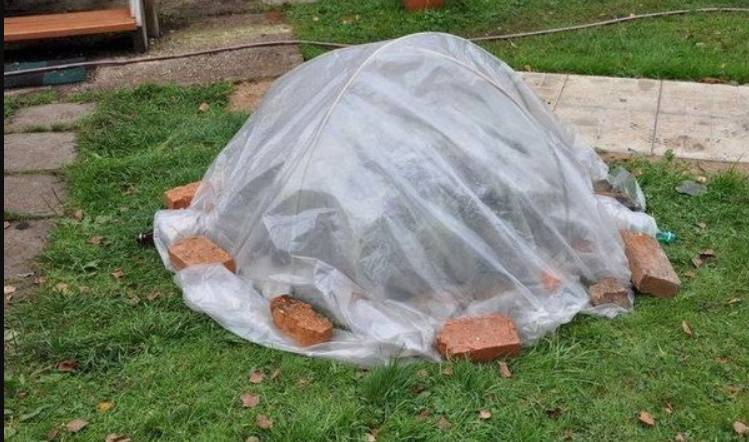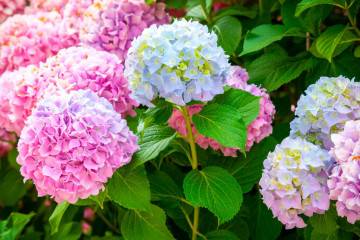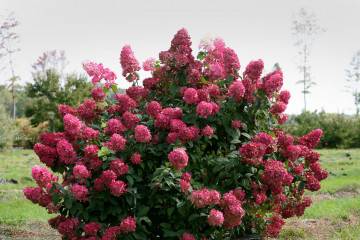Hydrangea Bombshell paniculata - description
Content:
Hydrangea Bombshell is an excellent ornamental plant that serves as a real decoration of the site. To achieve success in its cultivation, it is necessary to strictly follow the recommendations of specialists and provide the culture with careful care.
Hydrangea Paniculata Bombshell
Hydrangea paniculata Bombshell has compact spherical bushes.
It is often used in landscape design.
The origin and appearance of the Bombshell hydrangea
It is a relatively new variety that is of Dutch origin. The bushes grow up to 70-90 cm. They reach 100-120 cm in diameter. The plant branches strongly, but at the same time has a neat spherical shape. The branches of the shrub are quite thin and have a reddish-brown hue. The foliage is large and dark green in color.
Description of Bombshell hydrangea flower
According to the description, Bombshell hydrangea blooms from July until frost. The flowers are initially white, but by autumn they turn pink. They are no more than 2-3 cm in diameter, but at the same time the flowers form large pyramidal inflorescences. Their length reaches 12-14 cm.
Transplanting Bombshell hydrangea after purchase outdoors
To plant panicle hydrangea Bombshell in open ground, you must follow a number of recommendations. This is best done in the spring. The exact timing depends on the climate. At the same time, there should be no possibility of recurrent frosts.
Choosing the best place
Crop requires open, sunny areas. In this case, the plant should not be under the scorching rays all the time. It is best to plant hydrangeas near buildings and fences. This will provide her with protection from the wind.
Step-by-step planting process
To plant a culture, it is recommended to follow these rules:
- Make a hole 70 cm deep and 60-70 cm in diameter.
- Apply fertilizer before planting. For this, it is recommended to mix peat, fertile soil, sand and humus. This is done in a 2: 2: 1: 1 ratio.
- Lower the seedling into the ground and gently spread the roots.
- Sprinkle soil over the plant. In this case, the neck should rise slightly above its surface.
- Water the bushes abundantly. For 1 plant, you need to take 1 bucket of water.
Bombshell hydrangea propagation
You can propagate a culture in different ways. Most often, cuttings are used. The seed method is more suitable for breeding.
Propagation by cuttings
This is the most convenient breeding method. To carry out the procedure, you should do the following:
- Cut the cuttings in the spring or summer. Each of them must have at least 2 kidneys.
- The bottom of the cutting should be cut diagonally. This will make it easier to penetrate the soil.
- Immerse the planting material in a container with water. As a result, the cuttings will begin to form roots.After that, the plant should be transferred to a moist mixture of sand and peat.
- Place containers with seedlings in a greenhouse or on a windowsill. They can be planted in open soil next summer.
Growing from seeds
Planting seeds is recommended in February. They must be germinated before planting. For this, the planting material must be placed on wet cotton wool. When the seeds are swollen, they can be planted in the ground.
The plant needs nutritious soil. To do this, mix sand, peat and leafy soil in equal parts. The container must be filled with earth, and on top lay the seeds and sprinkle them with a layer of sand. Cover the container with glass or transparent film.
Bombshell Hydrangea Care
For a culture to grow and develop fully, it needs quality care. It should be comprehensive.
Watering mode
The culture does not tolerate excessive soil moisture. At the same time, severe drought also negatively affects the formation of the bush. Therefore, it is necessary to water the plant depending on the weather and soil condition.
Top dressing
It is recommended to feed the crop 3-4 times a year. In this case, the following scheme must be observed:
- In the spring, apply organic fertilizers that contain a lot of nitrogen. They contribute to the growth of green mass.
- When forming buds, urea, potassium salts, superphosphate should be added.
- In July, the plant should be fertilized with complex agents.
- In autumn, the culture needs potassium and phosphorus.
Features of care during flowering
In order for the culture to grow and develop normally, it needs to be systematically watered, pruned, and fed. Protection against diseases and parasites is also important.
Features of care during the rest period
With the onset of the dormant period, it is necessary to cut off old inflorescences. This is done until the kidneys are strong. Otherwise, the next flowering will become more scarce. Pruning of old and extra shoots is of no small importance.
The crop should be pruned in early spring - before the juices begin to move. To stimulate the active flowering of the plant, it is worth pruning weak, broken and dry shoots. You also need to get rid of crooked branches. As a result, only 10-12 of the strongest shoots should remain.
Preparing for winter
This culture is characterized by high frost resistance. However, young bushes need to be insulated with the arrival of autumn. To do this, it is recommended to spud the trunk circle with dry earth and cover it with a thick layer of fallen leaves. In winter, you need to scoop up snow to the plant. This will provide additional winter hardiness.
Hydrangea Bombshell is distinguished by abundant and long flowering. It serves as a real garden decoration and is often used to create various compositions. In order for the culture to retain its decorative effect as long as possible, it must be properly looked after.



















